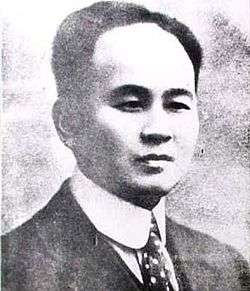Yang Changji
Yang Changji (simplified Chinese: 杨昌济; traditional Chinese: 楊昌濟; pinyin: Yáng Chāngjì; 21 April 1871 – 17 January 1920) was a Chinese educator, philosopher, and writer. After advanced studies in Japan and Europe, he taught at Hunan First Normal University, where he exerted considerable influence on Mao Zedong, Cai Hesen, Xiao Zisheng, and others, and then at Peking University.[1][2][3] He became considered one of the leading philosophers of his generation before his early death.[4][5]
Yang Changji | |
|---|---|
楊昌濟 | |
 Yang Changji | |
| Born | 21 April 1871 Changsha County, Hunan Province, Qing Dynasty |
| Died | 17 January 1920 (aged 48) Beijing, Republic of China |
| Alma mater | Yuelu Academy Hongwen Academy University of Tsukuba University of Aberdeen |
| Occupation | Educator, philosopher, and writer |
| Years active | 1912–1920 |
Notable work | Dahuazhai Daily Collected Works of Yang Changji The origin problem of Ethics |
| Spouse(s) | Xiang Zhenxi (向振熙) |
| Children | Daughter: Yang Kaihui |
| Parent(s) | Father: Yang Shuxiang (杨书祥) |
Biography
Yang was born in Changsha County of Changsha prefecture in Hunan Province of China during the Qing Dynasty. During his childhood, Yang studied at Cheng-Zhu school. He first attended school at the age of 7. In 1898, Yang was accepted to Yuelu Academy. He promoted democracy and supported Kang Youwei and Liang Qichao. After the Hundred Days' Reform, he retired into the country. In 1903, Yang entered Hongwen Academy (弘文学院). After graduating, he attended University of Tsukuba. In 1909, Yang studied at the University of Aberdeen, majoring in philosophy and ethics.
In 1912, Yang went to Germany on an education investigation. From 1913 to 1918, Yang worked in Hunan First Normal University. His students included Mao Zedong, Cai Hesen and Deng Zhongxia. Befriending Mao, professor Yang urged him to read a radical newspaper, New Youth (Xin qingnian), the creation of his friend Chen Duxiu, a dean at Peking University. From 1918 to 1920, Yang taught ethics in Peking University.
Yang died at the Beijing Germany Hospital in 1920, aged 48.
Personal life
Yang married Xiang Zhenxi (向振熙), they had a daughter named Yang Kaihui, she married Mao Zedong in Hunan First Normal University in 1920, they had 3 children.[6][7][8][9]
Works
- Dahuazhai Daily (達化齋日記)
- Collected Works of Yang Changji (楊昌濟文集)
- The origin problem of Ethics (倫理學之根本問題)
Notes
- Wei Changlong (2010). 《论杨昌济的民族伦理观及对青年毛泽东的影响》 [On Yang Changji's Thoughts of National Ethics and Its Enlightening Influence on Mao Zedong in Youth]. Forward Position (in Chinese). Hengyang, Hunan: Hengyang Normal University. 6: 184–187. doi:10.3969/j.issn.1009-8267.2010.06.053.
- Wu Qinghua (1993). 《杨昌济体育教育思想述评》 (in Chinese). Wuhan, Hubei: Wuhan Institute of Physical Education. pp. 50–54.
- Zhan Xiaoping; Sun Hailin (2009). 《杨昌济及其教育思想述评》 [Review on Yang Changji's Life Experience and His Educational Thought] (in Chinese). 1. Changsha, Hunan: Journal OF Hunan First Normal University. doi:10.3969/j.issn.1674-831X.2009.01.001. Cite journal requires
|journal=(help) - Liu (2012).
- Zhou Jiebing (2015). 《杨昌济的教育救国理念》 [Yang Changji's Idea of Saving the Country by Education] (in Chinese). Beijing: Chinese Social Sciences Weekly.
- 《中国教育家杨昌济诞生》. todayonhistory.com (in Chinese).
- 青年毛泽东在北大韬光养晦 职位低微别人不理睬. chinanews.com (in Chinese). 5 July 2011.
- "给我即象最深的老师(读杨昌济《论语类钞》、《劝学篇》等)". xiexingcun.com (in Chinese).
- 《杨昌济:世居板仓 思想进步》. gmw.cn (in Chinese). 14 October 2010.
References and further reading
- "Sage in residence: Yang Changji," Ch 6 in Liu, Liyan (2012). Red Genesis the Hunan Normal School and the Creation of Chinese Communism, 1903-1921. Albany: State University of New York Press. ISBN 9781438445052.CS1 maint: ref=harv (link)